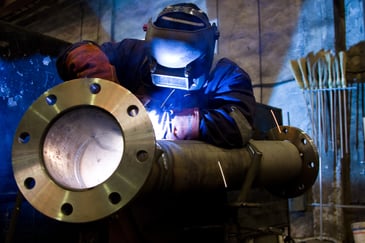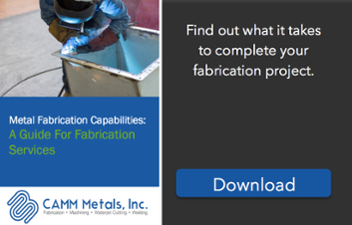
There’s a wide variety of metal fabrication projects that require welded parts. We understand that welding is a crucial aspect of the manufacturing process, but with so many different methods, it can be hard to understand the difference or determine which method is best.
Many people ask, “What’s the difference between MIG and TIG welding?” The two processes do have some aspects in common. Both processes use electrical arcs to produce heat and join metallic objects and both processes incorporate an inert gas mixture to prevent corrosion of welding electrode. Whether you’re unfamiliar or just need a quick review, read on for the differences between MIG welding and TIG welding.
How Does Each Process Work?
MIG, also commonly known as metal inert gas, welding is a process where a metal wire is continuously fed in to the weld being created. Essentially, the wire acts a s a filler material to help join together the two metal objects. On the other hand, TIG, or tungsten inert gas, welding incorporates a a non-consumable tungsten electrode, which runs a current through the metals being joined. TIG welding may or may not use a filler metal depending on the project.
In MIG and TIG welding, the molten weld pool is protected from the atmosphere by a shroud of inert gas around the arc; and though both of these welding techniques have their own advantages, one cannot be used in place of the other. They are not interchangeable and are intended for their specific purposes. MIG is ideal for larger projects while TIG welding lends itself beautifully with smaller projects including the use of more-exotic metals such as gold, nickel, and brass
What Makes Each Process Unique?
The continuous feed used in MIG Welding helps to reduce the probability of weld imperfections that could arise in pauses and intervals. This process is noticeably easy when compared to TIG welding since wire uncoils from the spools and is fed to the weld pool for the filling purpose.
TIG is applied in both the welding of ferrous and non-ferrous metals with a wide-range of thickness that do not exceed 8mm. Because this process is slower, the end result produces high-quality welds with perfect definition in aluminum, carbon steel and stainless steel. TIG welding is a super option when an especially high-quality of weld is necessary.
Which Process Requires More Experience to Use?
MIG welding is more suitable if you are seeking a solution based on ease of use. MIG welding is more forgiving of mistakes than TIG welding is, considering that TIG welding requires precise control over the timing, pressure, and electric current used in the weld.
Which Process Is Better Suited for Welding Thicker Metals?
Generally, MIG welding is the best option for thick heavy-duty welds. For thinner pieces of metal, we would recommend TIG welding tends to be the more effective option. Here’s why. As we mentioned earlier, MIG welding uses a filler material to make welds, it can often be helpful for completing welds of thicker metals in less time than a TIG weld.
Since TIG welding doesn’t use a filler material, the pieces of metal that are being welded must be hot enough to form a bond together, which is why it’s easier to use TIG Welding for thinner pieces of metal.
CAMM Metals | MIG and TIG Welding Services in CT
Here at CAMM Metals, after the welding portion of the project is complete, we offer many in-house services. These services include weld inspection with dye penetrant, acid cleaning and polishing of stainless steel welds. Additionally, we are also able to weld and test watertight enclosures. For those customers who require certified welds, we can certify our welds to AWS D1.1 & AWS D1.6.




